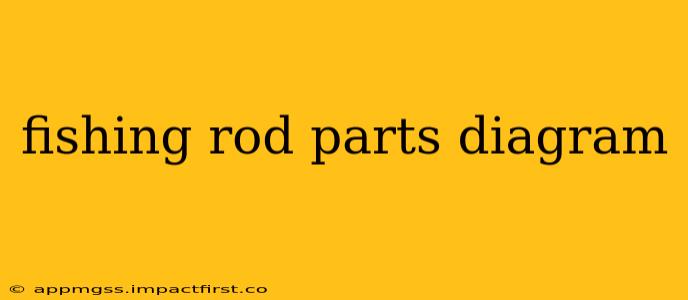Understanding the parts of your fishing rod is crucial for proper use, maintenance, and selecting the right equipment for your fishing style. This comprehensive guide will walk you through each component, explaining its function and importance. We'll also address some frequently asked questions to ensure you become a true fishing rod expert.
Key Parts of a Fishing Rod
A fishing rod, despite its seemingly simple design, comprises several vital parts working in harmony. Let's break them down:
1. Tip: This is the very end of the rod, the most slender part, often made of a flexible material. Its primary function is to detect subtle bites and transmit them to your hand. The tip's flexibility is crucial for casting and playing fish.
2. Tip-Top: Located at the very tip of the rod, the tip-top (also called a guide tip) is a small ring through which your fishing line passes. It minimizes friction and ensures smooth casting. Different tip-tops exist, each suited for specific line types.
3. Guides (or Rings): These are the rings along the rod's blank, running from the tip-top to the reel seat. They guide your fishing line, preventing tangles and ensuring smooth casting. The size and material of the guides are critical for optimal performance.
4. Rod Blank: This is the main body of the rod, providing the strength and action. The material is usually graphite (carbon fiber) or fiberglass, each offering different characteristics in terms of sensitivity, strength, and flexibility.
5. Reel Seat: This is the component that securely holds your fishing reel. Different reel seats have different clamping mechanisms, ensuring a firm grip on your reel.
6. Butt (or Handle): This is the part of the rod you grip. It's typically made of cork, EVA foam, or other comfortable materials, designed for a secure and comfortable hold. The length and material of the butt section vary greatly depending on the rod's purpose and style.
7. Hook Keeper: Some rods include a hook keeper near the reel seat, offering a convenient place to safely store your hook when not in use. This helps prevent accidental snags and keeps the hook secure.
Frequently Asked Questions (FAQs)
Here are some common questions about fishing rod parts that we'll address:
What are the different types of rod blanks?
Rod blanks are typically constructed from fiberglass or graphite (carbon fiber). Fiberglass rods are more flexible and forgiving, often preferred by beginners. Graphite rods are lighter, stronger, and more sensitive, ideal for experienced anglers. Composite blanks combine the properties of both materials.
What is the significance of rod action?
Rod action refers to the flexibility of the rod blank under load. Fast action rods bend primarily in the tip section, offering powerful casts and precise control. Medium-action rods bend along a larger portion of the blank, providing a balance of power and flexibility. Slow-action rods bend significantly throughout the blank, making them ideal for fighting large fish.
How do I choose the right guides for my rod?
Guide selection depends on your fishing line type and rod design. Ceramic guides are generally preferred for their smooth surface and durability, minimizing friction and improving casting distance. The size of the guides should be appropriate for the diameter of your fishing line to prevent line damage.
How important is the reel seat?
The reel seat is crucial for secure reel attachment. A poorly designed or damaged reel seat can lead to the reel coming loose during the fight, costing you a valuable catch. Ensure your reel is firmly secured before you start fishing.
What are the different handle materials?
Cork handles are traditional and provide a comfortable, secure grip. EVA foam handles are more durable, lightweight, and water-resistant, making them a popular alternative. Other materials like rubber or wood are sometimes used, each offering a unique feel and performance.
By understanding these components and their functions, you can select the right fishing rod for your needs and improve your overall fishing experience. Remember to always handle your rod with care to ensure its longevity.
